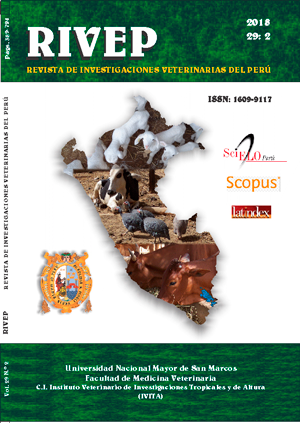IgG serum concentrations in alpacas neonates killed by enterotoxemia
DOI:
https://doi.org/10.15381/rivep.v29i2.14479Keywords:
serum IgG, enterotoxaemia, neonatal alpacasAbstract
The objective of the present study was to determine the levels of serum immunoglobulin G (IgG) in neonatal alpacas (5-23 days of age) killed by enterotoxemia and in animals of similar ages, but clinically healthy. In a first phase, a standard curve of physiological degradation of serum IgG was established from blood sera of six apparently healthy neonates from day 2 to 21 days of age (n=9). In a second phase, serum IgG concentrations were determined in 17 dead neonatal alpacas with lesions compatible with enterotoxemia and in 26 animals of similar ages, apparently healthy. The concentrations of IgG, determined by the Radial Immunodiffusion test, showed that all the animals at 48 hours of birth had adequate concentrations of IgG, while only three of the animals killed by enterotoxemia had IgG levels below the obtained standard curve, although only one of them with levels below 900 mg/dl at 14 days, which could be considered as a partial passive transfer failure. The serum IgG concentrations of the 26 clinically normal animals (2893 mg/dl) and those obtained from animals killed by enterotoxemia (2361 mg/dl) were statistically similar. The risk analysis using the Odds Ratio test (OR: 5.35, CI = 0.50-57.22) indicated that there is no association between adequate levels of IgG and mortality from enterotoxemia in neonatal alpacas.Downloads
Downloads
Published
Issue
Section
License
Copyright (c) 2018 Jorge Maximiliano G., Lenin Maturrano H., Hugo Castillo D., Karol Guzmán M., David Pérez J., Luis Luna E., Nidia Puray C., Raúl Rosadio A.

This work is licensed under a Creative Commons Attribution-NonCommercial-ShareAlike 4.0 International License.
AUTHORS RETAIN THEIR RIGHTS:
a. Authors retain their trade mark rights and patent, and also on any process or procedure described in the article.
b. Authors retain their right to share, copy, distribute, perform and publicly communicate their article (eg, to place their article in an institutional repository or publish it in a book), with an acknowledgment of its initial publication in the Revista de Investigaciones Veterinarias del Perú (RIVEP).
c. Authors retain theirs right to make a subsequent publication of their work, to use the article or any part thereof (eg a compilation of his papers, lecture notes, thesis, or a book), always indicating the source of publication (the originator of the work, journal, volume, number and date).










